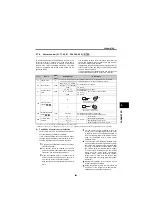
250
PARAMETER
2.6.4
Energy saving control and optimum excitation control [Pr. 60]
(common)
Without a fine parameter setting, the inverter automatically performs energy saving operation.
This inverter is optimum for fan and pump applications
(1) Energy saving operation mode [
Pr. 60 = 4
]
Set [
Pr. 60 = 4
] to perform operation with the minimum
output power.
1) Control method
After the output frequency has become constant
(acceleration or deceleration is complete), the
output voltage is reduced gradually and operation
is performed with the output power (product of
current and voltage) being minimum.
When the output current begins to increase due to
the increase in load torque, the output voltage is
increased up to the normal V/F pattern to
generate the torque required to maintain the
speed.
The output voltage is controlled within the range
of +0% to -50% in relation to the normal V/F
pattern, and the settings of [
Pr. 0 Torque boost
] and
[
Pr. 14 Load pattern selection
] are ignored. By
setting [
Pr. 60 = 0
] (Normal mode), the settings of
[
Pr. 0, Pr. 14
] are valid.
2) Restriction conditions
• When Advanced magnetic flux vector control,
Simple magnetic flux vector control, Real
sensorless vector control, or vector control is
selected, the selection of the energy-saving
mode is invalid.
• When the encoder feedback function has been
selected with the plug-in option (FR-A7AP) fitted
to the inverter, the selection of the energy-saving
mode is invalid.
3) Applications
• Machine which is operated for a long time at
constant speed, e.g. fan, air conditioner.
• Application in which large load torque is
applied
Since there is naturally little power
consumption loss, no energy-saving effect is
expected.
• Machine which makes frequent acceleration/
deceleration
Since torque is necessary for acceleration/
deceleration, no energy-saving effect is
expected.
4) Dedicated parameters
When constant speed is achieved in the energy-
saving mode, the output voltage is automatically
tuned and there are no dedicated parameters to
be set.
5) Energy-saving effect
The energy-saving effect depends greatly on the
load magnitude.
In applications such as air conditioning
equipment, inverter operation produces a larger
energy-saving effect on the running cost than
damper control by commercial power supply
operation. The energy-saving effect depends
greatly on the speed (load).
[
Pr.
]
Name
Initial Value
Setting
Range
Description
Available Inverters
60
Energy saving control
selection
0
0
Normal operation mode
4
Energy saving operation mode
—
9
Optimum excitation control mode
—
common
A700
F700
E700
D700
Appropriate application
Inappropriate application
A700
F700
Guideline of energy-saving mode
Energy-saving effect by air-conditioning equipment
Power consumption (%)
Normal mode
Energy-saving mode
100
50
0
50
100
Load (%)
Power consumption (%)
100
50
0
100
Speed (= air volume) (%)
Inverter
control
Damper control
Constant-torque
pattern
Variable-torque pattern
Energy-saving mode
50
Optimum excitation
control
Содержание FR-A700 Series
Страница 245: ...279 2 PARAMETER PARAMETER MEMO ...
Страница 440: ...474 PARAMETER MEMO ...
Страница 522: ...556 SELECTION MEMO ...
















































